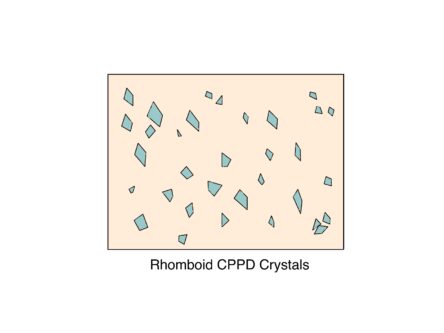Calcium Pyrophosphate Crystal
Deposition Disease (CPPD)
What is Calcium Pyrophosphate Crystal Deposition Disease?
CPPD is group of conditions related to the formation of calcium crystals in joints, tendons and can result in causing inflammatory arthritis. There are 3 types of calcium that can be deposited in joints, the most common being Calcium PyroPhosphate (CPP). Although just because crystals are present in the joint, it doesn’t always correlate with symptoms.
Acute CPP crystal arthritis was previously known as Pseudogout as its presentation is similar to gout but the crystals are formed of different substances.
Acute CPP crystal arthritis presents with pain, swelling and redness, most commonly in the elderly. Knees are the most commonly affected joints. The crystal formation in and around the joints can cause inflammation resulting in the symptoms felt.

Causes of Acute CPP Crystal Arthritis
Acute CPP crystal arthritis can be caused by genetic and environmental factors. However in the majority of people with this arthritis, no clear cause is found.
Men and women are usually affected equally and it is commoner in those over 60 years.
The most common association of crystal deposition is osteoarthritis (OA).
A number of less common conditions make CPP crystal deposition more likely at a younger age. These include:
- Hypophosphatasia
- A rare disorder of bone formation
- Primary Hyperparathyroidism
- Excess hormones released from small glands in the next leading to high blood calcium levels
- Familial hypoercalciuric Hypercalcaemia
- A rare genetic condition leading to high calcium levels in the blood due to reduced loss in the urine
- Haemochromatosis
- A genetic disorder leading to accumulation of iron in the body
- Hypomagnesaemia
- Low levels of magnesium in the body due to a number of different causes.
Symptoms of Acute CPP Crystal Arthritis
Joint symptoms:
- Severe pain, redness and stiffness in a joint
- Pain often comes on quickly and reaches its peak at around 12-24 hours
- Joints most commonly affected are the knees. Although it can occur in wrists, shoulders and ankles.
- In the majority of cases, one joint is affected at a time.
- Flares of joint symptoms can be triggered by trauma, illness and surgery.
- Symptoms usually settle down after 7-10 days without treatment
- Flares are often very intermittent with long periods between them
How do we diagnose CPPD
Imaging:
- CPPD is most commonly diagnosed on imaging.
- Calcium deposits can be seen on X-rays as areas of white in the joint spaces and on cartilages between bones and over tendons. This is called chondrocalcinosis.
- However, just having the CPPD does not necessarily mean you will have the symptoms of an acute flare.
Joint aspiration:
- If the diagnosis is not obvious, the best test is to take a sample of the fluid in the swollen joint and look for crystals under a microscope. However this may not always be possible in smaller joints.
Treatment
There are no known treatments to prevent or reduce CPPD, management is based on symptomatic relief of the acute joint when there is a flare.
Resting the affected joint and using ice packs best treats acute CPP crystal arthritis. Medication targeting the pain and inflammation should be taken as quickly as possible when the flare starts:
- NSAIDS
- Colchicine
- Steroids- either targeted injection into a large joint, or a short course of tablets
Often taking off some of the fluid of the larger joints can help relieve the pressure and pain.
Useful Links
Versus Arthritis: http://www.versusarthritis.org
